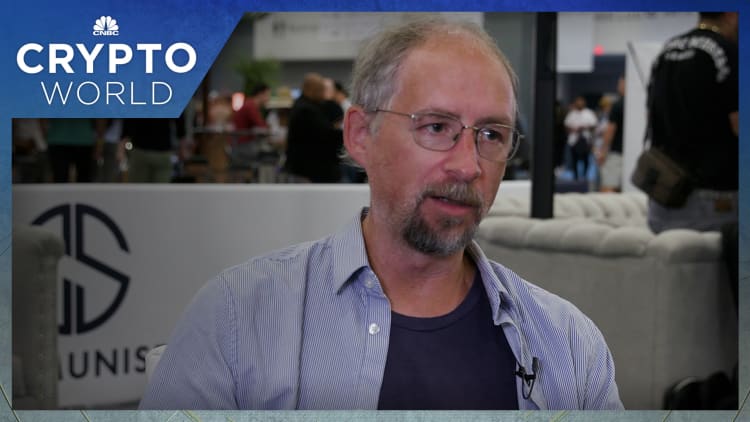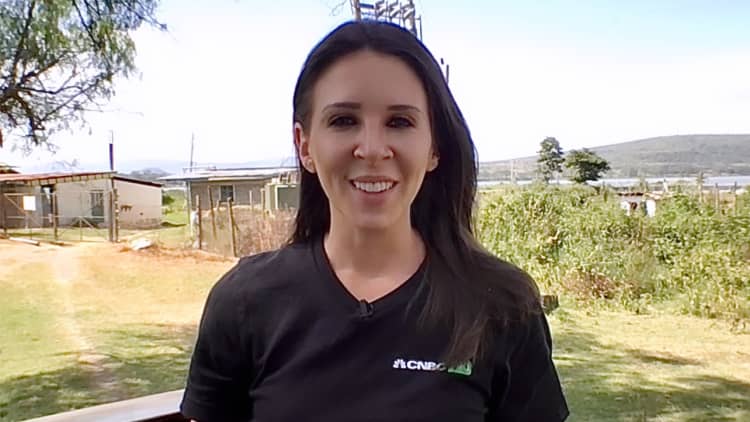
watch
now
AUSTIN,
TEXAS
—
Adam
Sullivan
left
investment
banking
to
mine
bitcoin
at
an
awkward
time.
It
was
May
2023,
bitcoin
was
trading
at
around
$21,000,
U.S.
regulators
were
in
the
thick
of
cracking
down
on
the
sector
writ
large,
and
Core
Scientific,
the
company
he
had
agreed
to
take
over,
was
battling
angry
lenders
in
a
Texas
bankruptcy
court
over
tens
of
millions
of
dollars
in
outstanding
debt.
But
Sullivan
knew
that,
with
a
lifeline,
he
could
get
the
business
to
a
much
better
place.
That’s
because
the
halving
was
on
the
way,
and
with
it
would
likely
come
a
big
rally
in
bitcoin.
Late
Friday
night,
the
bitcoin
code
automatically
cut
new
issuance
of
the
world’s
largest
cryptocurrency
in
half.
It
happens
roughly
every
four
years,
and
in
addition
to
helping
to
stave
off
inflation,
it
historically
precedes
a
major
run-up
in
the
price
of
bitcoin.
The
technical
event
is
relatively
simple:
Bitcoin
miners
get
paid
in
bitcoin
to
validate
transactions,
and
after
210,000
blocks
of
transactions
are
computed
and
added
to
the
main
chain,
the
reward
given
to
the
miners
securing
bitcoin
is
‘halved.’
There
are
more
than
a
dozen
publicly
traded
miners
on
the
network
and
thousands
of
smaller,
private
ones
around
the
globe,
constantly
racing
to
process
transactions
and
get
paid
in
new
bitcoin.
Because
the
event
leads
to
a
cut
to
rewards
paid
to
miners
directly,
they’ll
be
the
first
ones
to
feel
the
impact
of
the
halving.
The
price
of
bitcoin
has
touched
new
all-time
highs
after
each
“halving”
event.
CNBC
Typically,
when
the
halving
cuts
supply,
it’s
led
to
huge
rallies
for
bitcoin.
In
fact,
the
previous
(and
only)
three
halvings
in
the
chain’s
history
have
come
before
every
bull
run,
in
which
the
coin
has
touched
new
all-time
highs
and
a
surge
of
investors
have
entered
the
market
for
the
first
time.
That
rapid
price
increase
has
helped
many
miners
stave
off
the
worst
since
it
tends
to
offset
the
impact
of
having
the
block
prize
cut
in
half.
“As
a
company
that
was
already
in
the
process
of
scaling
our
infrastructure
during
the
previous
halving,
we
know
the
toll
that
halvings
can
take
on
a
company
if
it
is
not
adequately
prepared,”
Core’s
Sullivan
told
CNBC.
The
aggregate
market
cap
of
the
14
U.S.-listed
bitcoin
miners
tracked
by
JPMorgan
analysts,
which
accounts
for
around
21%
of
the
global
Bitcoin
network,
declined
28%
over
the
first
half
of
April
to
$14.2
billion,
reaching
year-to-date
lows.
Bitdeer
was
the
best-performing
stock
over
the
period,
down
around
20%,
versus
Stronghold
Digital,
which
was
46%
lower.
Some
have
billed
the
2024
bitcoin
halving
as
a
seminal
moment
for
the
mining
sector.
Depending
on
how
much
prep
work
miners
have
done,
it
could
easily
make
or
break
them.
“Being
prepared
for
a
halving
means
evaluating
all
of
your
power
strategies,
all
of
your
software
capabilities,
all
of
your
operations,”
continued
Sullivan.
Others
are
less
concerned
given
recent
price
moves
in
bitcoin.
In
a
research
note
from
Needham
on
Apr.
16,
analysts
said
they
expect
the
halving
to
only
have
a
modest
impact
to
miners’
estimated
EBITDA
margins,
despite
the
50%
reduction
in
revenue,
since
the
price
of
bitcoin
has
been
trading
in
the
range
of
$60,000
to
$70,000.
“We
expect
geopolitical
tensions
and
interest
rate
policy
to
be
the
biggest
near-term
drivers
of
crypto
price
action,”
Needham
analysts
wrote,
adding
that
at
a
bitcoin
price
above
$60,000,
the
halving
is
“derisked
for
nearly
all
public
miners.”
The
bank
did,
however,
single
out
their
preference
for
low-cost
bitcoin
producers
like
Riot
Platforms,
Bitdeer,
and
Cipher
Mining.
Meanwhile,
if
bitcoin
prices
fall,
Needham
says
the
most
outsized
native
impact
will
be
felt
by
higher
cost
producers
that
are
also
levered
to
higher
bitcoin
prices
via
large
treasury
holdings.
Analysts
from
JPMorgan
echoed
a
similar
sentiment,
writing
in
an
Apr.
16
research
note
that
they
think
“recent
weakness
offers
an
attractive
entry
point”
for
investors
and
that
they
are
“especially
bullish”
on
Riot,
which
they
believe
offers
attractive
relative
valuations.
Power
supply
for
Whinstone’s
bitcoin
mine
in
Rockdale,
Texas.
Years
spent
bracing
for
the
halving
Miners
have
had
years
to
prepare
for
the
halving,
including
seeking
lower
power
costs
and
upgrading
their
fleets
to
more
efficient
machines.
“Bitcoin’s
halving
happens
like
clockwork
every
four
years,”
said
Haris
Basit,
chief
strategy
officer
of
Bitdeer
Technologies
Group.
“It’s
a
known
variable
that
is
a
benchmark
for
us
to
remain
focused
on
operational
excellence.”
To
that
end,
the
Singapore-headquartered
mining
firm
has
invested
in
new
data
centers,
but
its
core
strategy
has
been
to
increase
vertical
integration
through
research
and
development.
25%
of
its
staff
is
focused
on
R&D
efforts,
which
Basit
says
have
“led
to
new
innovations
and
revenue
pathways,
such
as
our
recently
announced
4nm
mining
rigs
and
AI
Cloud
offerings.”
Analysts
at
Cantor
Fitzgerald
recently
named
Bitdeer
as
having
one
of
the
industry’s
lowest
“all-in”
cost-per-coin.
Greg
Beard,
the
CEO
and
Chairman
of
Stronghold
Digital
Mining,
tells
CNBC
that
miners
whose
only
lever
is
more
efficient
machines
will
be
at
a
disadvantage.
“Miners
who
own
their
low-cost
power
are
better
positioned,”
said
Beard.
“Operational
costs
will
be
lower,
allowing
them
to
be
more
flexible
with
their
capital.”
Core’s
Sullivan
agrees,
noting
that
bitcoin
mining
data
centers
in
the
future
will
work
hand-in-glove
with
power
generators
and
grid
operators
to
serve
as
a
virtual
battery
for
grid
operators
–
allowing
them
to
increase
base
load,
curtail
bitcoin
data
centers
when
they
need
to,
and
avoid
peak
generation
loads,
which
he
says
are
dirty
and
expensive.
“We
own
and
operate
our
infrastructure,
giving
us
greater
control
over
operational
and
strategic
decisions,
such
as
the
potential
to
expand
into
high-performance
computing
hosting,”
said
Sullivan.
Core
Scientific,
which
launched
in
2017
and
now
manages
seven
mining
sites
in
five
U.S.
states,
also
owns
the
full
technology
stack.
The
company
has
been
looking
to
diversify
its
revenue
streams
beyond
purely
bitcoin.
Sullivan
says
that
existing
data
centers
offer
reconfiguration
opportunities
to
accommodate
new
types
of
high-value
compute.
“Certain
data
centers
are
located
in
close
proximity
to
major
metropolitan
areas,
making
them
candidates
for
low-latency,
high-value
compute
applications,”
said
Core’s
CEO.
Bitdeer’s
bitcoin
mine
in
Rockdale,
Texas.
Riot
Platforms
CEO
Jason
Les
told
CNBC
that
preparation
for
the
halving
came
down
to
the
company’s
long-standing
focus
on
achieving
a
low
cost
of
power,
strong
balance
sheet,
and
significant
scale
of
operations.
Les
says
that’s
what
has
positioned
the
firm
to
both
withstand
the
halving
with
positive
margins
and
be
well
positioned
for
upside
on
the
other
side
of
it.
“Our
new
Corsicana
Facility
was
energized
just
this
week,
and
we
will
be
significantly
scaling
up
our
hash
rate
with
next-generation
equipment
at
that
new
site
over
the
remainder
of
the
year,”
said
Les.
“As
a
result,
we
are
positioned
to
mine
more
bitcoin
per
day
at
the
end
of
the
year
than
we
do
today,
despite
the
halving.”
Marathon
Digital,
which
has
seen
its
stock
rise
more
than
70%
in
the
last
year,
took
a
different
approach
to
scaling
the
business
than
its
rivals.
CEO
Fred
Thiel
tells
CNBC
that
the
company
grew
quickly
using
an
asset-light
approach,
where
Capex
was
spent
on
mining
rigs
rather
than
infrastructure.
“In
December,
we
owned
less
than
5%
of
the
sites
where
we
were
hosting
our
miners,”
said
Thiel.
“Today
we
now
own
53%
of
our
total
1.1
gigawatts
of
capacity,
having
purchased
it
at
less
than
the
build
and
replacement
cost.”
Owning
sites
lowers
Marathon’s
cost
to
mine
by
up
to
20%
on
a
marginal
cost
basis.
Thiel
also
noted
that
by
the
end
of
2024,
Marathon
expects
to
further
improve
efficiency
by
10%
to
15%
as
they
deploy
the
next
generation
rigs
across
their
new
sites.
That
boost
to
efficiency
isn’t
just
about
new
gear,
however.
The
firm
is
deploying
its
own
custom
firmware,
which
allows
it
to
operate
even
more
efficiently.
Marathon,
along
with
other
mining
firms,
has
begun
diversifying
its
business
model
into
ancillary
operations
beyond
purely
bitcoin
mining,
as
well.
Thiel
says
the
company
recently
launched
an
energy
harvesting
division,
where
they
are
compensated
for
converting
stranded
methane
and
bio-mass
into
energy,
which
they
then
sell
heat
back
into
an
industrial
or
commercial
process.
The
service
essentially
subsidizes
and
lowers
Marathon’s
cost
to
mine
significantly.
The
company
expects
this
new
business
line
to
generate
a
significant
portion
of
its
revenues
by
the
halving
in
2028.

watch
now
Diversifying
revenue
The
April
2024
bitcoin
halving
looks
a
lot
different
than
the
three
that
came
before
it.
For
years,
increased
competition
resulting
from
new
miners
coming
online
has
been
cutting
into
profits,
because
more
miners
means
more
people
are
sharing
the
same
pool
of
rewards.
In
a
research
note
from
JPMorgan
on
Apr.
16,
analysts
note
that
the
network
hashrate,
a
proxy
for
industry
competition
and
mining
difficulty,
was
up
4%
in
April
from
the
month
before.
Stronghold’s
Beard
says
the
halving
is
a
headwind
dwarfed
by
the
global
hashrate
increasing
nearly
five-fold
from
the
last
one
in
May
2020.
“Mining
is
a
tough
industry
especially
because
there
are
a
lot
of
nation
states
that
have
extra
power
power
and
they’re
dedicating
it
to
mining,”
said
Nic
Carter
of
Castle
Island
Ventures.
“It’s
a
free
market,
anybody
can
enter
into
it
as
long
as
they
have
the
basics.”
U.S.
spot
bitcoin
exchange-traded
funds
have
also
significantly
shifted
the
pricing
dynamics.
In
years
past,
the
price
of
bitcoin
didn’t
surge
until
after
the
halving.
But
in
the
wake
of
record
flows
into
these
spot
bitcoin
funds,
the
world’s
largest
cryptocurrency
touched
a
fresh
all-time-high
above
$73,000
in
March.
“The
recently
approved
bitcoin
ETFs
have
proven
to
be
huge
pipelines
of
capital
into
bitcoin
and
that
universe
of
ETFs
continues
to
grow
with
the
recent
approvals
in
Hong
Kong
as
well,”
said
Riot’s
Les.
“We
think
the
price
action
we’ve
seen
in
bitcoin
year-to-date
reflect
that
and
has
us
very
optimistic
on
what
bitcoin
mining
economics
can
look
like
in
the
months
and
years
post-halving.”

watch
now
Blackrock’s
ETF
reached
$17
billion
in
net
assets
within
a
few
months
of
launching.
Beard
of
Stronghold
tells
CNBC
that
if
Blackrock
added
even
just
a
billion
dollars
more
of
bitcoin
in
April
to
its
ETF,
it
would
single
handedly
create
demand
for
more
coins
than
the
mining
industry
will
supply
post
halving.
What
is
also
different
this
time
around
is
that
the
block
reward
is
no
longer
the
primary
form
of
miner
revenue.
Recent
programming
innovations
in
bitcoin
have
given
way
to
a
burgeoning
ecosystem
of
projects
building
on
top
of
bitcoin’s
blockchain,
which
has
translated
to
greater
transaction
fee
revenue
for
miners.
There
is
a
limit
to
how
large
the
blocks
can
go
but
the
value
of
those
blocks
is
about
to
increase
significantly,
according
to
Bill
Barhydt,
who
is
the
CEO
and
founder
of
Abra.
From
Barhydt’s
vantage
point,
he
supports
miners
with
a
mix
of
services,
including
their
auto
liquidations,
so
he
has
access
to
a
lot
of
macro
data
across
the
sector.
“The
math
is
simple,”
begins
Barhydt.
“Bitcoin
blocks
are
fixed
in
size
and
the
demand
for
data
within
those
blocks
is
going
to
increase
significantly
for
several
reasons,
including
more
retail
wallet
holders
moving
their
bitcoin
into
and
out
of
storage,
new
uses
cases
like
Ordinals
(NFTs
for
bitcoin)
and
DeFi
on
bitcoin,
institutional
settlement
requirements
for
exchange
traded
products
in
the
U.S.,
Hong
Kong,
Europe,
etc.,
lightning
settlement
transactions,
and
more.”
At
the
current
rate
of
adoption,
Barhydt
believes
that
transaction
fees
in
this
cycle
would
likely
peak
within
24
months
at
10
times
their
cost
during
the
previous
cycle
peak,
due
to
a
combination
of
a
higher
price
for
bitcoin
itself,
combined
with
higher
demand
for
the
space
inside
each
block.
Castle
Island’s
Carter
isn’t
so
sure
that
fee-based
revenue
can
completely
make
up
for
lost
income
post-halving.
“It’s
not
entirely
clear
that
fees
are
fully
offsetting
the
lost
revenue,
and
in
fact,
I
don’t
expect
that
to
happen”
said
Carter.
Fees
tend
to
be
really
cyclical.
They
rise
sharply
during
periods
of
congestion,
and
they
fall
back
to
near
zero
during
other
normal
periods.
Carter
cautions
that
miners
will
see
spikes
in
fees,
but
there
is
not
yet
an
enduring,
strong,
and
robust
fee
market
most
of
the
time.

watch
now
Swapping
ASICs
for
AI
In
the
last
year,
there
has
been
a
surge
in
demand
for
AI
compute
and
infrastructure
that
can
support
the
massive
workloads
required
to
power
these
novel
machine
learning
applications.
In
a
new
report,
digital
asset
fund
manager
CoinShares
says
it
expects
to
see
more
miners
shift
toward
artificial
intelligence
in
energy-secure
locations
because
of
the
potential
for
higher
revenues.
Already,
mining
firms
like
BitDigital,
Hive,
Hut
8,
Terawfulf,
and
Core
Scientific
all
have
either
current
AI
operations
or
AI
growth
plans.
“This
trend
suggests
that
bitcoin
mining
may
increasingly
move
to
stranded
energy
sites
while
investment
in
AI
grows
at
more
stable
locations,”
write
analysts
at
CoinShares.
But
pivoting
from
bitcoin
mining
to
AI
isn’t
as
simple
as
re-purposing
existing
infrastructure
and
machines.
The
data
center
requirements
are
different,
as
are
the
data
network
needs.
“AI
presents
several
challenges,
notably
the
need
for
distinct
and
considerably
more
costly
infrastructure,
which
establishes
barriers
to
entry
for
smaller,
less
capitalized
entities,”
continues
the
report.
“Additionally,
the
necessity
for
a
different
skill
set
among
employees
leads
to
increased
costs
as
companies
hire
more
AI-skilled
talent.”
The
rigs
used
to
mine
bitcoin
are
called
ASICs,
short
for
Application-Specific
Integrated
Circuits.
The
“Specific”
in
that
acronym
means
that
it
can’t
be
used
to
do
other
things,
like
supporting
the
underlying
infrastructure
for
AI.
“If
you’re
a
bitcoin
miner,
your
machines
can’t
be
repurposed,”
explains
Carter.
“You
have
to
buy
net
new
machines
in
order
to
do
it
and
the
data
center
requirements
are
different
for
AI
versus
bitcoin
mining.”
Sullivan
says
that
Core
Scientific,
which
has
been
mining
a
mix
of
digital
assets
since
2017,
began
to
diversify
into
other
services
in
2019.
“The
company
has
owned
and
hosted
Nvidia
DGX
systems
and
GPUs
for
AI
computing,
having
built
and
deployed
a
specialized
facility
specifically
for
high-value
compute
applications
at
our
Dalton,
Georgia
data
center
campus,”
he
said.
Core
Scientific
has
also
partnered
with
CoreWeave,
a
cloud
provider
which
provides
infrastructure
for
use
cases
like
machine
learning.
Sullivan
says
the
combined
capabilities
will
support
both
AI
and
High
Performance
Compute
workloads,
resulting
in
an
estimated
revenue
of
$100
million,
though
he
says
the
total
potential
revenue
is
much
higher
given
their
significant
infrastructure
footprint
that
can
be
fitted
to
host
some
of
the
most
advanced
GPU
compute
coming
to
market.
“Bitcoin
mining
is
an
early
example
of
high-value
compute,
attracting
significant
capital
and
a
number
of
companies
scaling
their
operations
to
support
the
Bitcoin
network,”
said
Sullivan.
But
Sullivan
thinks
few
operators
will
be
able
to
make
the
transition
to
AI.
Sullivan
continued,
“Bitcoin
mining
sites
can
only
be
repurposed
if
they
meet
the
attributes
that
are
required
for
HPC.
Many
existing
sites
across
North
America
do
not
meet
these
needs.”

watch
now
